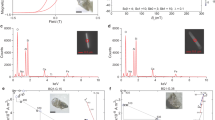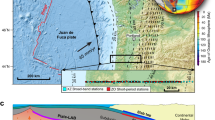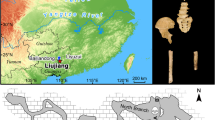Abstract
Recent exploration has revealed extensive geological evidence for a water-rich past in the shallow subsurface of Mars. Images of in situ and loose accumulations of abundant, haematite-rich spherical balls from the Mars Exploration Rover ‘Opportunity’ landing site at Meridiani Planum1,2,3 bear a striking resemblance to diagenetic (post-depositional), haematite-cemented concretions found in the Jurassic Navajo Sandstone of southern Utah4,5. Here we compare the spherical concretions imaged on Mars to these terrestrial concretions, and investigate the implications for analogous groundwater-related formation mechanisms. The morphology, character and distribution of Navajo haematite concretions allow us to infer host-rock properties and fluid processes necessary for similar features to develop on Mars. We conclude that the formation of such spherical haematite concretions requires the presence of a permeable host rock, groundwater flow and a chemical reaction front.
This is a preview of subscription content, access via your institution
Access options
Subscribe to this journal
Receive 51 print issues and online access
$199.00 per year
only $3.90 per issue
Buy this article
- Purchase on Springer Link
- Instant access to full article PDF
Prices may be subject to local taxes which are calculated during checkout



Similar content being viewed by others
References
NASA Jet Propulsion Laboratory. Mars Exploration Rover Mission 〈http://marsrovers.jpl.nasa.gov〉 (February–March 2004).
Glotch, T. D. et al. Hematite at Meridiani Planum: Detailed spectroscopic observations and testable hypotheses. Lunar Planet. Sci. Conf. XXXV [online] Abstr. 2168; 〈http://www.lpi.usra.edu/meetings/lpsc2004〉 (2004)
Squyres, S. W. et al. Initial results from the MER Athena Science investigation at Gusev Crater and Meridiani Planum. Lunar Planet. Sci. Conf. XXXV [online] Abstr. 2187, 〈http://www.lpi.usra.edu/meetings/lpsc2004〉 (2004)
Chan, M. A., Parry, W. T. & Bowman, J. R. Diagenetic hematite and manganese oxides and fault-related fluid flow in Jurassic sandstones, southeastern Utah. Am. Assoc. Petrol. Geol. Bull. 84, 1281–1310 (2000)
Chan, M. A. & Parry, W. T. Rainbow of rocks: mysteries of sandstone colors and concretions in Colorado Plateau Canyon Country. (Utah Geological Survey Public Information Service, Salt Lake City, Utah, 2002); 〈http://www.ugs.state.ut.us/online/pdf/pi-77.pdf〉.
Christensen, P. R., Morris, R. V., Lane, M. D., Bandfield, J. L. & Malin, M. C. Global mapping of Martian hematite mineral deposits: Remnants of water-driven processes on early Mars. J. Geophys. Res. 106, 23873–23885 (2001)
Newsom, H. E. et al. Paleolakes and impact basins in southern Arabia Terra, including Meridiani Planum: Implications for the formation of hematite deposits on Mars. J. Geophys. Res. 108, doi:10.1029/2002JE001993 (2003)
Catling, D. C. & Moore, J. M. The nature of coarse-grained crystalline hematite and its implications for the early environment of Mars. Icarus 165, 277–300 (2003)
Hynek, B. M., Arvidson, R. E. & Phillips, R. J. Geological setting and origin of Terra Meridiani hematite deposit on Mars. J. Geophys. Res. 107, doi:10.1029/2002JE001891 (2002)
Ormö, J. & Komatsu, G. Hydrocarbon related bleaching of strata and hematite deposition in red beds at Moab, Utah: A possible analogous process that formed bright layers and hematite deposits on Mars. Lunar Planet. Sci. Conf. XXXIV [online] Abstr. 1356, 〈http://www.lpi.usra.edu/meetings/lpsc2003〉 (2003)
Beitler, B., Ormö, J., Komatsu, G., Chan, M. A. & Parry, W. T. Geomorphic and diagenetic analogs to hematite regions on Mars: Examples from Jurassic Sandstones of Southern Utah, USA. Lunar Planet. Sci. Conf. XXXV [online] Abstr. 1289, 〈http://www.lpi.usra.edu/meetings/lpsc2004〉 (2004)
Antonellini, M. & Aydin, A. Effect of faulting on fluid flow in porous sandstones: geometry and spatial distribution. Am. Assoc. Petrol. Geol. Bull 79, 642–671 (1995)
Hood, J. W. & Patterson, D. J. Bedrock Aquifers in the Northern San Rafael Swell Area, Utah, with Special Emphasis on the Navajo Sandstone. Technical Publication 78 (Utah Department of National Research, 1984).
Chan, M. A., Parry, W. T., Petersen, E. U. & Hall, C. M. 40Ar-39Ar age and chemistry of manganese mineralization in the Moab to Lisbon fault systems, southeastern Utah. Geology 29, 331–334 (2001)
Beitler, B., Parry, W. T. & Chan, M. A. Bleaching of Jurassic Navajo Sandstone on Colorado Plateau Laramide Highs: Evidence of exhumed hydrocarbon supergiants? Geology 31, 1041–1044 (2003)
Parry, W. T., Chan, M. A. & Beitler, B. Chemical bleaching indicates fluid flow in sandstone deformation bands. Am. Assoc. Petrol. Geol. Bull. 88, 175–191 (2004)
Beitler, B., Chan, M. A. & Parry, W. T. Field mapping and multispectral analysis of Jurassic Navajo Sandstone color and iron mineralization, Grand Staircase-Escalante National Monument, Utah. Geol. Soc. Am. Abstr. 34, 277 (2002)
Ortoleva, P. T. Geochemical Self-Organization (Oxford Univ. Press, 1994)
Cornell, R. M. & Schwertmann, U. The iron oxides: Structures, properties, reactions, occurrences and uses. (VCH, New York, 1996)
Adamovic, J. in Ironstones Pseudokarst Reports 2 (eds Adamovic, J. & Cilek, V.) 7–40 (Czech Speleological Society, Zlaty Kun, Prague, 2002)
Nuccio, V. F. & Condon, S. M. Burial and thermal history of the Paradox Basin, Utah and Colorado, and petroleum potential of the middle Pennsylvanian Paradox Formation. US Geol. Surv. Bull. 76, O1–O41 (1996)
Morgan, P. & Gosnold, W. D. in Geophysical Framework of the Continental United States (eds Pakiser, L. C. & Mooney, W. D.) 493–522 (Geological Society of America Memoirs Vol. 172, Boulder, Colorado, 1989)
Minitti, M. E., Lane, M. D. & Bishop, J. L. A new hematite formation mechanism for Mars. Lunar Planet. Sci. Conf. XXXV [online] Abstr. 1999, 〈http://www.lpi.usra.edu/meetings/lpsc2004〉 (2004)
Hoffman, N. White Mars: A new model for Mars' surface and atmosphere based on CO2 . Icarus 146, 326–342 (2000)
Fernández-Remolar, D. et al. The Tinto River, an extreme acidic environment under control of iron, as an analog of the Terra Meridiani hematite site of Mars. Planet. Space Sci. 53, 239–248 (2004)
Acknowledgements
We thank the donors of the American Chemical Society Petroleum Research Fund, and the Bureau of Land Management-Grand Staircase Escalante National Monument for partial support of this research (to M.A.C. and W.T.P.). The work by J.O. was supported by the Spanish Ministry for Science and Technology and the Ramon y Cajal Program. The work by G.K. was supported by funding from the Italian Space Agency.
Author information
Authors and Affiliations
Corresponding author
Ethics declarations
Competing interests
The authors declare that they have no competing financial interests.
Rights and permissions
About this article
Cite this article
Chan, M., Beitler, B., Parry, W. et al. A possible terrestrial analogue for haematite concretions on Mars. Nature 429, 731–734 (2004). https://doi.org/10.1038/nature02600
Received:
Accepted:
Issue Date:
DOI: https://doi.org/10.1038/nature02600
This article is cited by
-
Characteristics, distribution, and origin of ferruginous deposits within the Late Ordovician glaciogenic setting of Arabia
Scientific Reports (2023)
-
Terrestrial Martian Analog Heritage of Kachchh Basin, Western India
Geoheritage (2022)
-
Understanding genesis of iron oxide concretions present in Dhandraul (Vindhyan) Sandstone: Implications in formation of Martian hematite spherules
Journal of Earth System Science (2021)
-
Ichnology of the Middle Jurassic hiatus concretions from Poland: implications for their formation, exhumation, and palaeoenvironment
Palaeobiodiversity and Palaeoenvironments (2020)
-
The blueberry (iron nodule) from the Shark Bay area, Western Australia and its implication to the genetic environments of iron nodules on Mars
Science China Earth Sciences (2016)
Comments
By submitting a comment you agree to abide by our Terms and Community Guidelines. If you find something abusive or that does not comply with our terms or guidelines please flag it as inappropriate.



